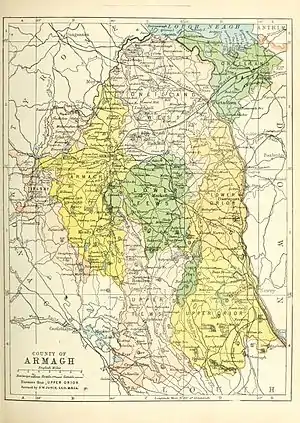Coney Island, Lough Neagh
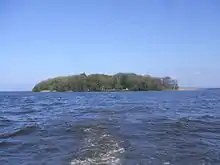
Coney Island is an island in Lough Neagh, Northern Ireland. It is about 1 km offshore from Maghery in County Armagh, is thickly wooded and of nearly 9 acres (36,000 m2) in area.[1] It lies between the mouths of the River Blackwater and the River Bann in the south-west corner of Lough Neagh.[2] Boat trips to the island are available at weekends from Maghery Country Park or Kinnego Marina.[3] The island is owned by the National Trust and managed on their behalf by Armagh City, Banbridge and Craigavon Borough Council.[4] Coney Island Flat is a rocky outcrop adjacent to the island.[5] Although Samuel Lewis called Coney Island the only island in County Armagh,[6] Armagh's section of Lough Neagh also includes Croaghan Island, as well as the marginal cases of Padian and Derrywarragh Island.[7]
Name
The original Irish name of the island was Inis Dabhaill, "island of the Blackwater", so named because it lies opposite where the river Blackwater enters Lough Neagh.[8] In English it was called Enish Douel[8] and then Sidney's Island.[9] The current name comes from coney, meaning "rabbit".[8]
History
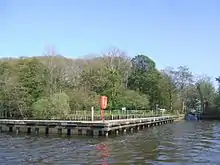
Coney Island has a rich history with long evidence of human occupation. This causeway was breached in the 19th century to allow the passage of barges from the Bann to the Blackwater.[2]
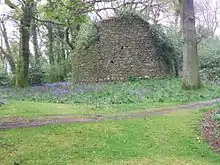
It features a 13th-century Anglo-Norman motte.[10]
A native settlement flourished there in the later Middle Ages when there was also a small iron industry. Subsequently, the island was refortified with a bank, ditch and an external palisade.[2]
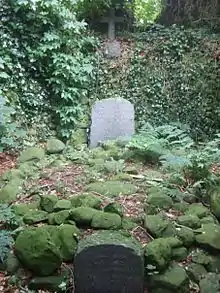
It also has a 16th-century stone tower.[10] The island was one of the O'Neill's major strongholds, but was delivered to Lord Deputy Sir Henry Sydney in 1567, and appears to have continued in use as a fort for a generation at least. At some later point the defences were thoroughly razed. In the 17th and 18th centuries the island was only sporadically occupied.[2]
In the 1890s, Coney Island was bought by James Alfred Caulfield (1830-1913), 7th Viscount Charlemont, supposedly for £150. He lived in Drumcairne, just outside Stewartstown, and bought the island building a summer house in 1895.[11] In 1946, the island was given to the National Trust by Fred Storey.[1]
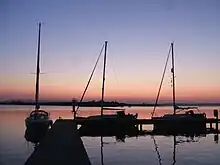
References
- "Coney Island". Coney Island, Lough Neagh, Northern Ireland. Archived from the original on 23 July 2008. Retrieved 6 August 2010.
- Addyman, P. V. (1965). "Coney Island, Lough Neagh: Prehistoric Settlement, Anglo-Norman Castle and Elizabethan Native Fortress: An Interim Report on Excavations in 1962 to 1964". Ulster Journal of Archaeology. 28: 78–101. JSTOR 20627417.
- "Lough Neagh Boat Trips". Discover Northern Ireland. Archived from the original on 15 January 2010. Retrieved 6 August 2010.
- "Coney Island". Culture Northern Ireland. Archived from the original on 5 April 2012. Retrieved 6 August 2010.
- Greer, Philip John (1971). Holiday Cruising in Ireland: A Guide to Irish Inland Waterways. David & Charles. pp. 126–7. ISBN 9780715350034.
- Lewis, Samuel (1837). "County Armagh Topography". A Topographical Dictionary of Ireland.
- "MapViewer". Northern Ireland Environment Agency. Archived from the original on 31 August 2013. Retrieved 1 September 2013.
- Coney Island. Place Names NI.
- "Maghery and Coney Island". Craigavon Museum. Archived from the original on 5 December 2008. Retrieved 7 August 2010.
- Stewart, Linda (9 November 2009). "Reserves of splendour to savour at Lough Neagh". Belfast Telegraph. Retrieved 3 March 2020.
- Capper, W. Caring for the Countryside
